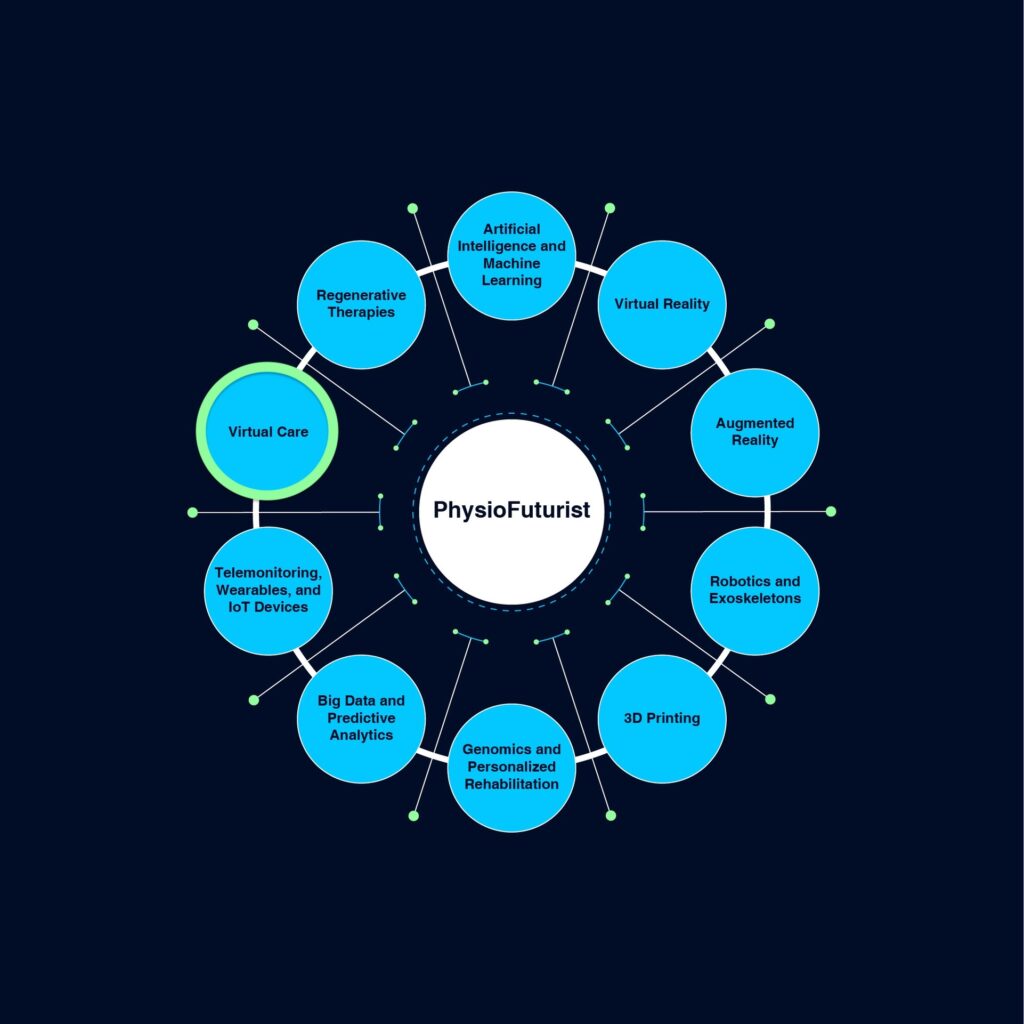This is the tenth guest post in a series written by Jason Giesbrecht – Physiopedia Plus Instructor, Senior Healthcare Leader and Physiotherapist.

The COVID-19 pandemic has acted as a catalyst for a profound shift towards Virtual Care within healthcare sectors globally, placing physiotherapy at the vanguard of this transformation. As physiotherapists worldwide adapted to delivering care remotely, the very foundation of rehabilitation was reshaped. This significant shift has not only necessitated adaptability but also highlighted the vast potential of Virtual Care to redefine physiotherapy practices and revolutionize patient outcomes.
The current landscape of virtual physiotherapy
Virtual Care in physiotherapy leverages telemedicine, smartphone apps, wearable devices, patient portals, and online platforms to extend care beyond traditional clinic visits. Propelled into the mainstream by pandemic-induced restrictions, this approach has proven its capability to enhance rehabilitation by offering both convenience and expanded access to care.
Despite initial reservations, the effectiveness of virtual physiotherapy for various conditions has been widely acknowledged by both practitioners and patients, demonstrating Virtual Care’s capabilities in real-world settings. This includes the successful adaptation of exercises, patient education, and certain manual therapy techniques to online platforms.
Benefits of Virtual Care
For healthcare providers, Virtual Care enhances practice efficiency and scope by enabling services to reach patients in remote or underserved areas, providing flexible scheduling, and employing a data-driven approach to care through real-time health data from wearables and IoT devices. This not only improves patient outcomes but also allows for proactive intervention and progress monitoring.
Patients experience a transformation in care delivery through Virtual Care, eliminating the need for travel and making healthcare accessible from home, which is especially beneficial for those with mobility issues or living in areas with limited specialized care access. Virtual Care also fosters patient engagement and adherence through technology, offering a more personalized and responsive healthcare experience.
Broader societal advantages
Beyond direct benefits, Virtual Care contributes to societal advantages by reducing travel needs, thus aligning with global climate change efforts through decreased carbon emissions and reduced transportation system strain. Moreover, the shift towards Virtual Care promises cost savings for healthcare systems by lessening the demand for physical clinic spaces.
Challenges and innovations
Transitioning to Virtual Care presents challenges such as the need for specialized training, technology access, administrative adjustments, and sustainable reimbursement models. Nonetheless, the integration of AI, wearable technologies, and advancements in remote monitoring and immersive learning through AR and VR promises to make rehabilitation more dynamic, engaging, and tailored.
The ethical landscape
Adopting Virtual Care necessitates addressing ethical considerations such as equity, privacy, data security, and autonomy to ensure it is accessible to all without exacerbating healthcare disparities. This demands a balanced approach to innovation and ethical responsibility.
Navigating the human connection in a digital age
Virtual Care does not diminish the human element in physiotherapy but rather offers an opportunity to enhance the therapist-patient relationship through hybrid care models and hyper-personalization, making healthcare more responsive and patient-centered.
The road ahead
The full embrace of Virtual Care requires a cultural and systemic shift within the physiotherapy profession, addressing technological adoption barriers, funding, licensure issues, and quality care perceptions. Moreover, ensuring equitable access to Virtual Care remains crucial.
Looking to the future, integrating Virtual Care with technological advancements like 3D printing, genomics, and robotics promises to further revolutionize physiotherapy, making it more accessible, personalized, and effective.
Envisioning a future with biologics and stem cell therapies
The next installment of the PhysioFuturist blog will explore regenerative therapies, including stem cells and platelet-rich plasma treatments, poised to redefine rehabilitation. These therapies, leveraging the body’s repair mechanisms, represent the next frontier in physiotherapy, promising more natural and effective healing approaches.
As we navigate the evolving landscape of physiotherapy illuminated by Virtual Care, our commitment to innovation, equity, and patient care remains steadfast, guiding us towards a future where technology and expertise merge to create unparalleled rehabilitation experiences. Let’s collectively embrace this future, revolutionizing physiotherapy for the betterment of all.
Jason would love to hear your ideas on this topic, feel free to reach out to him at [email protected] to discuss the topic further; and you can follow him on Twitter and Instagram.